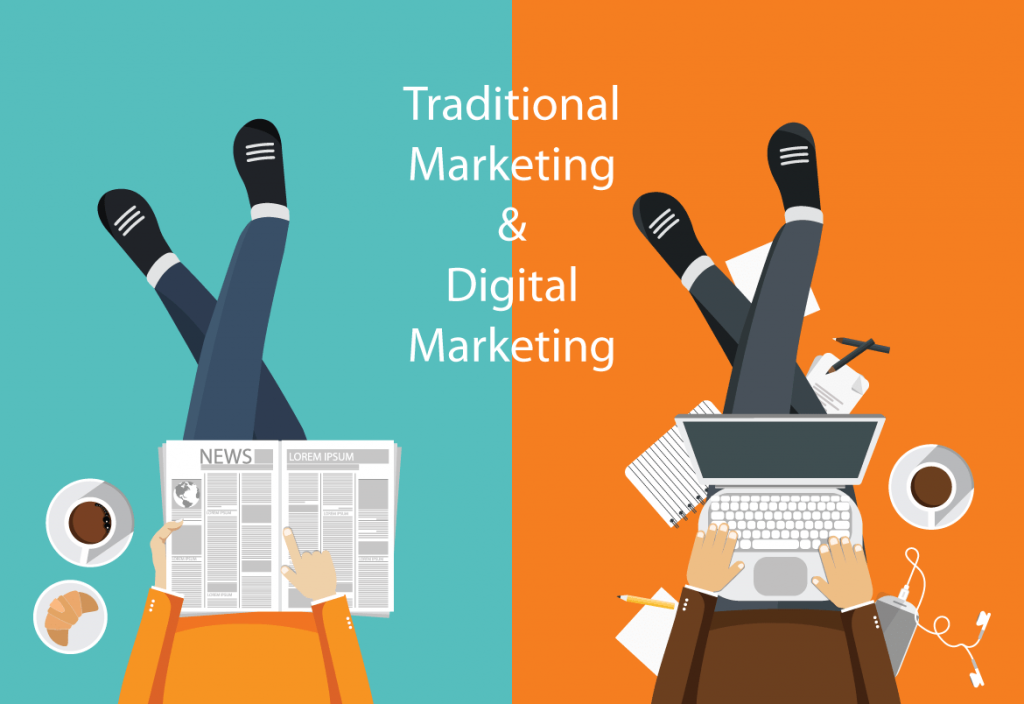What came first, the chicken or the egg? In this case, it’s no doubt that the pioneer of marketing, traditional marketing, came before digital. Both marketing strategies have disadvantages and advantages, but we’d like to define the differences to help you in deciding which strategy is the best for achieving your company’s goals.
Traditional Marketing
Traditional marketing is what our society has been exposed to for decades, and we passively interact with this type every day. Traditional relies on mass communication: newspapers, magazines, billboards, television and radio broadcasts, and printed flyers are traditional marketing strategies we are all aware of. If you haven’t lived in the forest and rejected mainstream culture, then you’ve viewed this type of traditional marketing, say, about a million or so times.
Traditional is ideal when a company’s objective is brand awareness. This form of marketing is about an extensive reach, and it doesn’t consider the impact of engagement. This can make it difficult to measure the success of a conventional advertisement. Questions such as how many conversions did this advertisement create? Have the sales been affected by this strategy? cannot be specifically answered. Traditional depends on reaching the masses; the more a brand can place their name on billboards, television, radio, and flyers, the better the results.
And they’re not wrong, we haven’t stopped relying on traditional because its a powerful attention grabber. Handing out physical flyers, business cards, newsletters demand greater emotional processing than digital marketing. If an individual can touch or see it in real life, they’re more willing to believe in it.
Turning towards traditional does have its downfalls. Since you are publicizing your brand to the masses, you’re spending your budget on getting attention from prospects who aren’t necessarily interested in your products or services. Plus, the operational costs for running new campaigns is very high, therefore adjusting any details after production is out of the question. There’s little room for testing to see what the consumer responds best to.
A lot of the gaps within traditional are filled by digital marketing, traditional’s chosen heir. The opposing benefits of each strategy are striking, but worthwhile in learning to better understand what path to take for your brands.
Digital Marketing
Ah, digital marketing. The tech-savvy, modern version of traditional. While traditional marketing is widely known and easy to point out, digital is presented in a variety of different ways, some ways more apparent than others. Commons forms of digital marketing are search engine ads (Google, Bing, Yahoo), display, video, content, email, social media, and other forms of digital media. Digital marketing strategy is ideal for those with a smaller budget who want to tailor their approach to optimize advertising.
While traditional advertising targets the masses and emphasizes brand awareness, digital advertising is selective in how a message is presented. Although brand awareness is a significant objective, digital prioritizes targeting the right consumers to increase audience engagement and conversions of a product or service. The ideal consumer or “buyer’s persona” can be narrowed down due to digital’s informative measurements and calculations of ROI; therefore, traditional’s approach may miss the mark.

In order to identify target users, digital collects data through software which assesses who interacts with their websites or online ads. Types of data collected can be age, location, range, interests, and behaviors of these individuals. These target capabilities enable brands to steer their marketing campaigns in the right direction and allow for adjustments along the way. With online strategy, there is greater control of the message as a result of analyzing measurements than simply putting a billboard up and hoping the message will increase sales.
Additionally, a digital campaign can easily extend internationally. While traditional may only be able to create mass advertisements nationally or locally, digital can reach any individual with an internet connection. There’s also the possibility of your ad campaign going viral, like Moonpie’s celebrated Twitter account, full of weird yet relatable tweets that have gained popularity.
“So, is traditional or digital best for my company?”
In considering the information presented above, ask yourself these questions:
1 | How small or big is my budget? Digital fits all types of budgets, but if your company’s budget leans toward the smaller side, then digital will provide more bang for your buck. Larger budgets fit well with traditional marketing.
2 | Am I seeking brand engagement or awareness? If you’re looking to optimize brand engagement, digital is more suitable. If you are seeking awareness, consider traditional.
3 | Do I want to interact with my audience? Digital creates a platform for two-sided communication, while traditional is a one-sided form of communication.

4 | Am I looking to reach the general public or a specific demographic? Traditional prioritizes reaching as many people as possible, so this would be the better option in reaching the general public. To more narrowly target a specific demographic, choose digital.
5 | How much control do I want for my ad campaign? In traditional, there’s very little room to adjust details and measure performance. Digital campaigns deploy with analytics and tools to administer needed changes.
Lastly, before deciding, consider this…
The most optimal way to market a product or service is applying both digital and traditional to your campaign. This can be referred to as the “no stone unturned method.” You’re applying the advantages of both methods to create a greater chance of awareness, engagement, and conversions. Consider what happened to Tide and their television advertisement during the 2018 Super Bowl. The clever concept of declaring every other Super Bowl ad a Tide ad due to the actors’ pristine, clean outfit caused a racket on social media. Memes of #TideAd showed up on all social media platforms.
Make sure you’re picking the right strategy for your company’s goals to guarantee improved conversions, higher levels of brand awareness, and a clearer understanding of your target audience.
